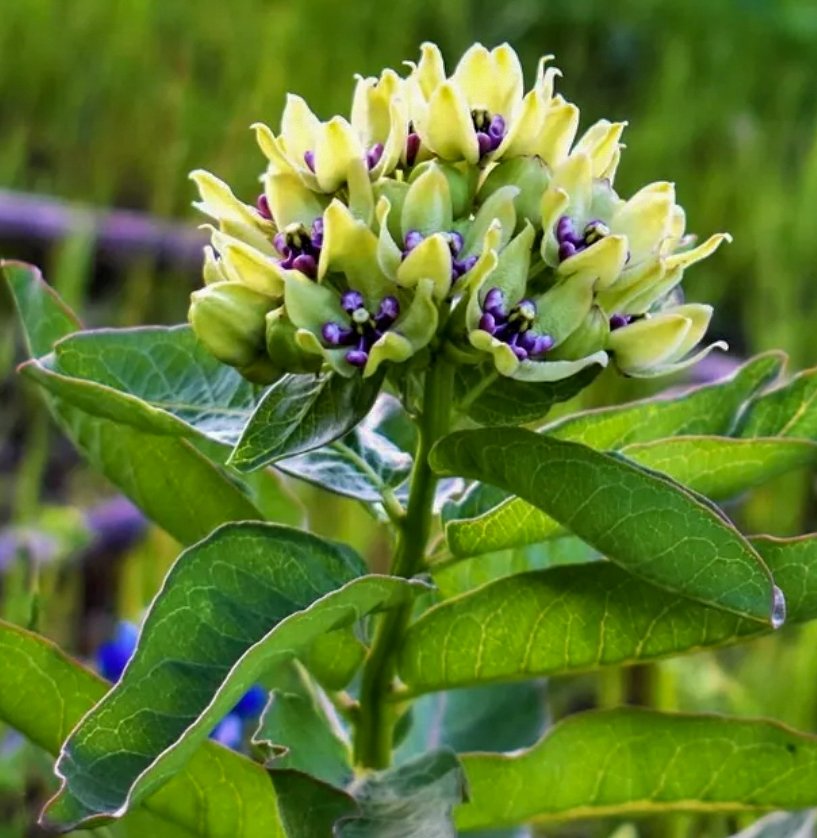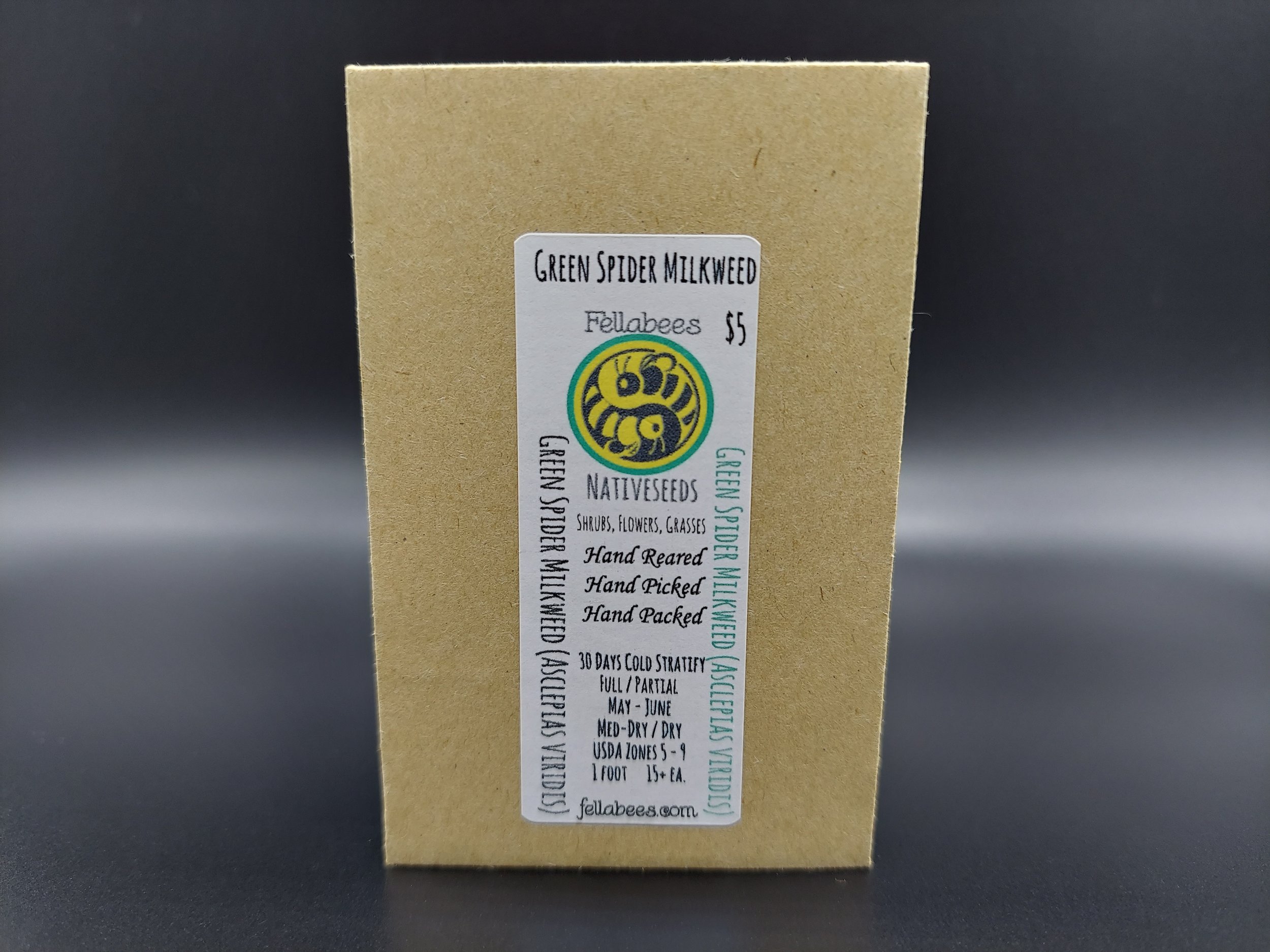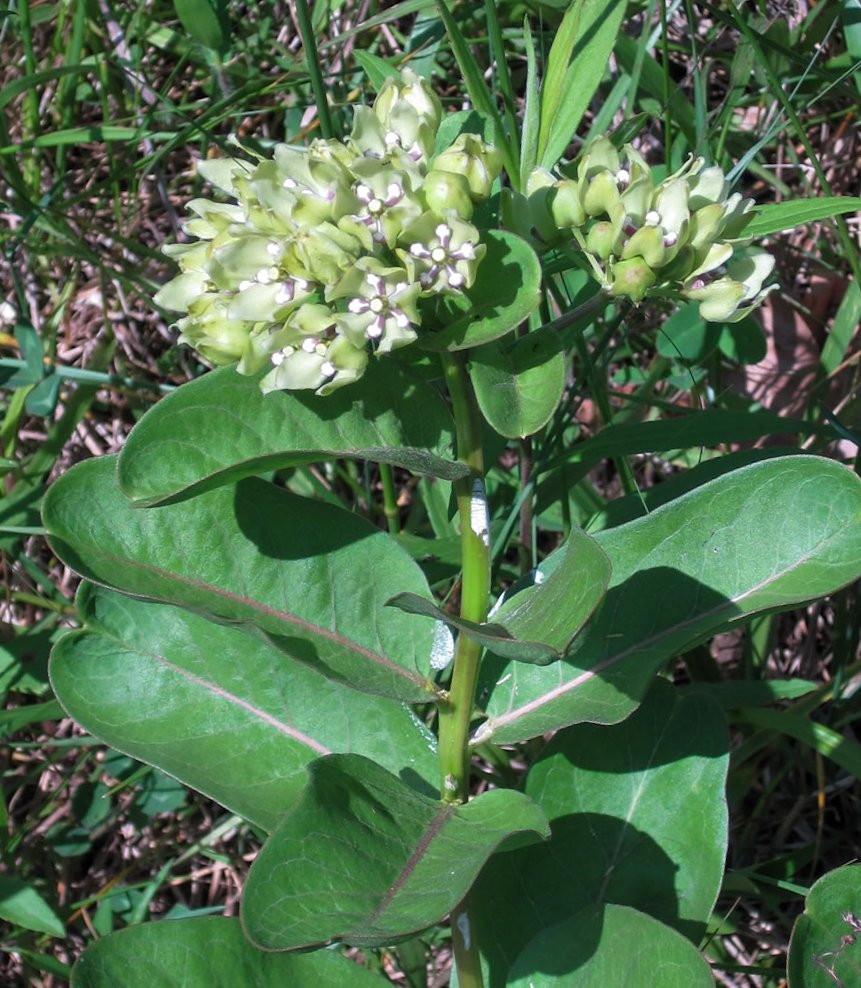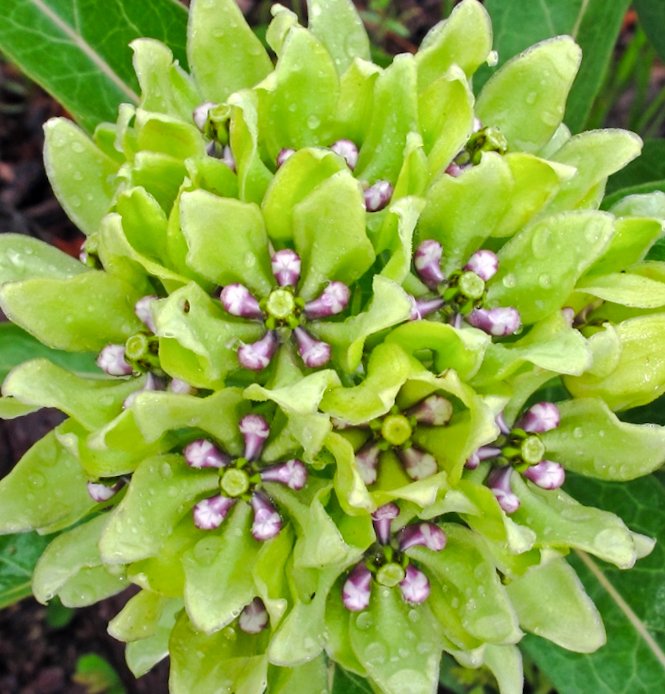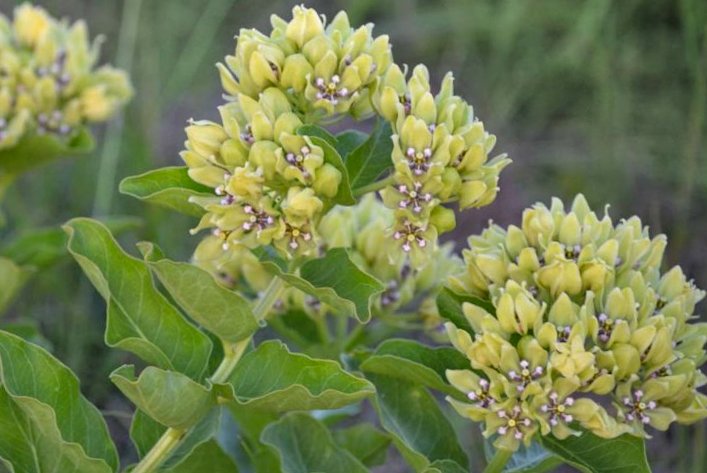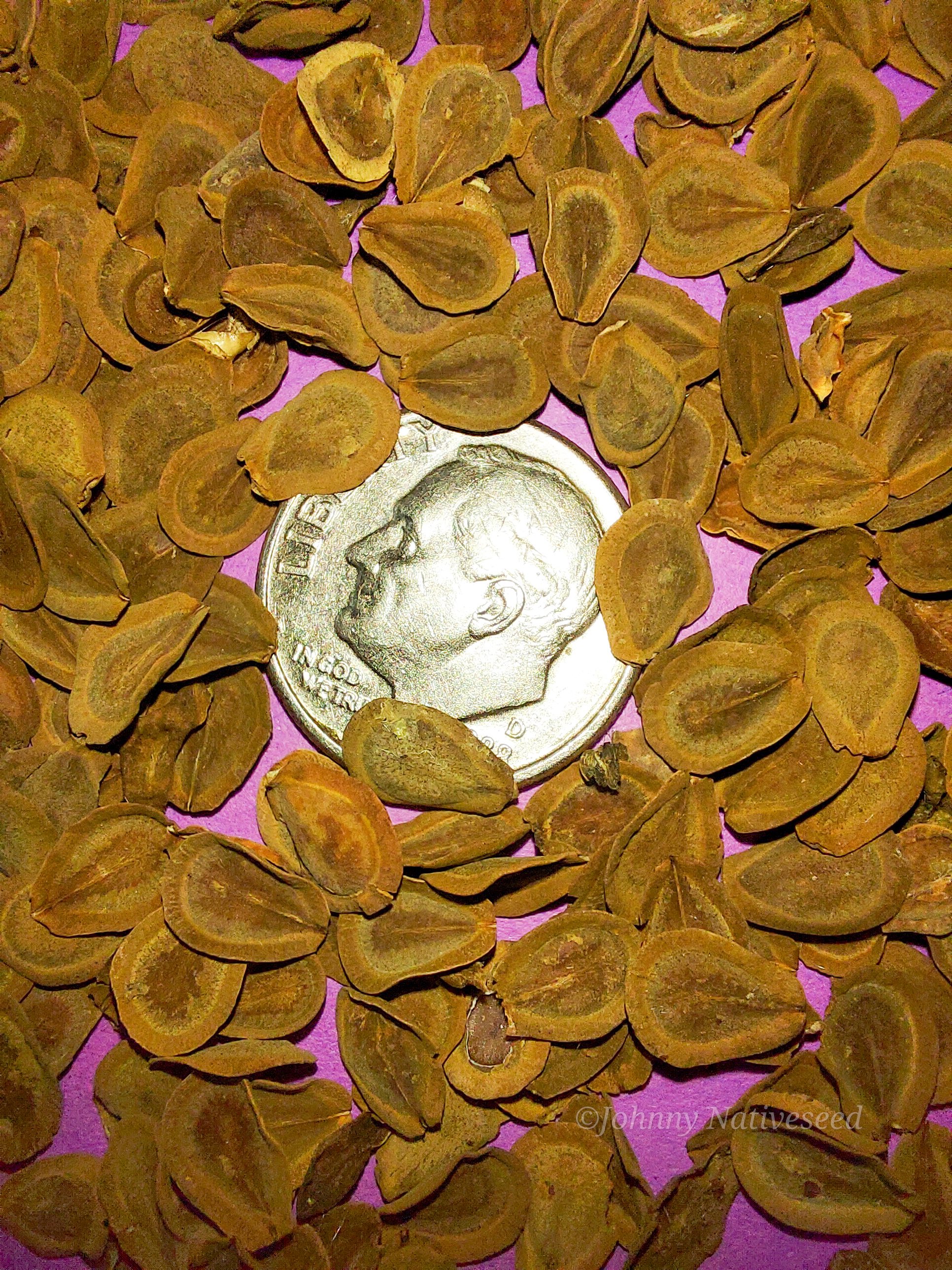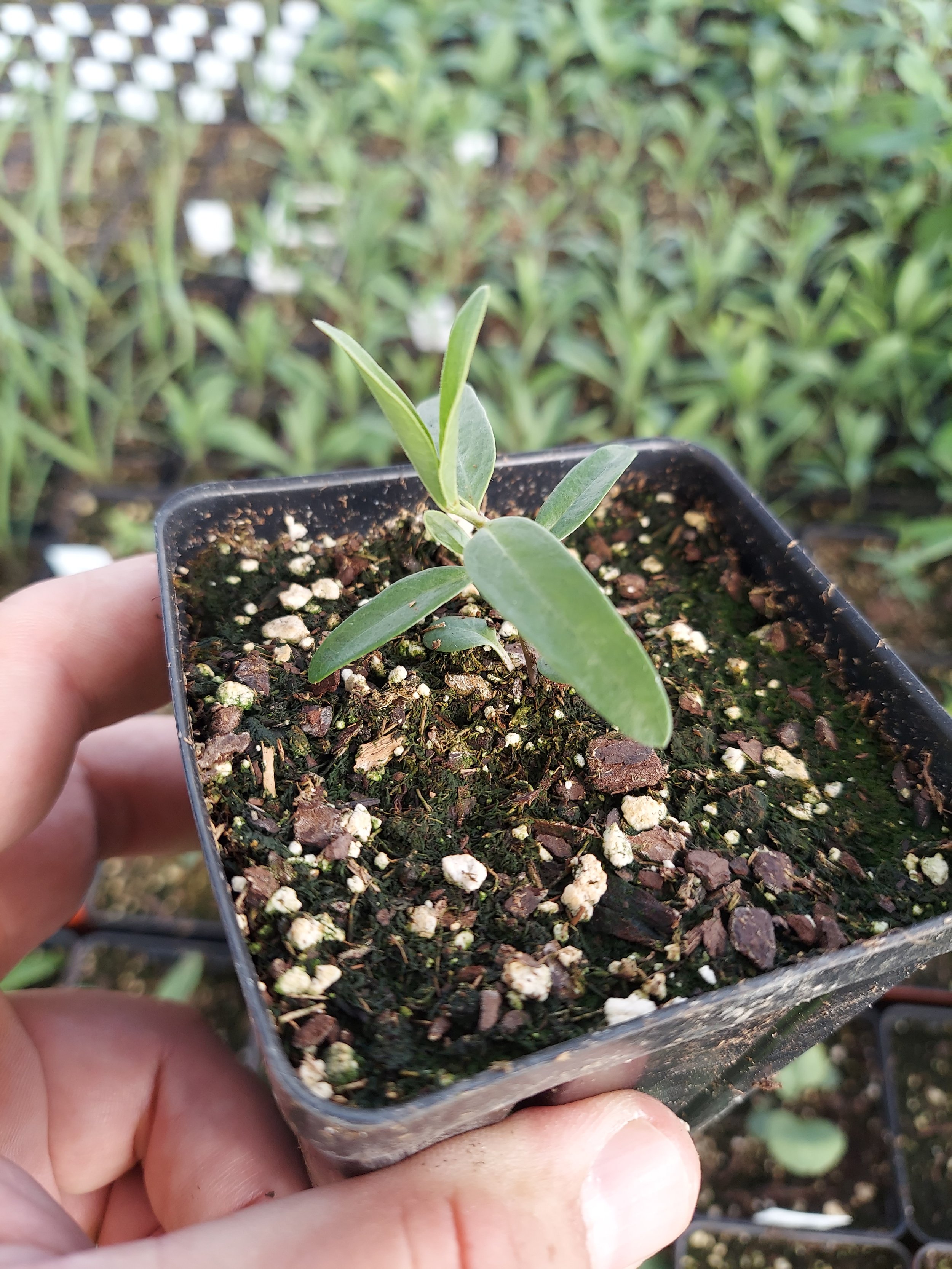Green Spider Milkweed (Asclepias viridis)
Green Spider Milkweed (Asclepias viridis)
Green Spider Milkweed is a common name regionally descibing the scientificly named native plant Asclepias viridis which is a species of milkweed. As with all Milkweed it is a plant in the dogbane family known by other, regionally common names such as Green Milkweed, Green Antelopehorn and Spider Milkweed.
The Latin word viridis means green, owing to its most obvious color, but when it blooms, it reveals a deep purple interior. Green Spider Milkweed is native to the midwestern, south central and southeastern United States, as well as to the southeastern portion of Western United States.
Green Spider Milkweed is a shorter perennial forb with alternately arranged leaves. The inflorescence is an umbel of white flowers with purplish centers Its root system is a taproot, much like that of Butterfly Milkweed (Asclepias tuberosa).
Green Spider Milkweed grows in many types of soil. It is common spotted in overgrazed pasture land and roadsides, mostly because it is not enjoyed by herbivores who will avoid most mature Milkweed species.
Like some other milkweed species, (Asclepias viridis) is a host plant for the Monarch Butterfly (Danaus plexippus).
Asclepias virdis is one of the very first milkweeds to bloom in the Midwest (May to June). In that area, monarch butterfly and milkweed tussock moth (Euchaetes egle) caterpillars are seldom found on the plant as it sheds its leaves and becomes dormant in late June to early July before the two Lepidoptera species arrive. However if one desires, the plant can be trimmed back before going to seed, to flush with fresh leaves for later arrivials to utilize.
Like other Milkweed with taproot, this plant resists being grown in containers, and if started in trays after appropriate stratification, they should be transplanted to plug trays with deep bottoms to accommodate, and not confine the taproot. If the taproot hits bottom, the plant may not perform well when planted in its permanent place in the soil.
This plant is considered present but more rare in Indiana, West Virginia, and Georgia.
While this plant is already present in Wisconsin, Minnesota, Iowa, and Michigan, it would be technically out of its traditional native range in these states, however there is a good case made for planting this valuable host plant for Monarchs arriving in the northern states earlier than they have historically, due to changes in yearly average temperatures which are increasing, pushing species north earlier in their migration patterns.
Plant Details
USDA Zones: 5-9
Germination Needs: 30 Days Cold Stratification,
Life Cycle: Perennial
Sun Exposure: Full to Partial
Soil Moisture: Medium-Dry, Dry
Plant Spacing: 2-3 feet
Height: 1 foot
Bloom time: May, June
Bloom Color: Green
Advantages
Pollinator Favorite: butterflies, moths, bees, wasps, beetles
Deer Resistant: Yes
Excellent in the dry home landscape!
Native to: Illinois, Ohio, West Virginia, Kentucky, Tennessee, Georgia, Alabama, Mississippi, Louisiana, Texas, Arkansas, Oklahoma, Kansas, Nebraska.
Introduced to: Wisconsin, Minnesota, Iowa and Michigan.
.
.
Packet quantities:
We pride ourselves on ethical, hands on, ecological management, using no mechanical or chemical methods whatsoever.
All of our native seed is hand reared, hand picked, and hand packed from native prairies under our exclusive management, never breaking chain of custody from the field until it is sent to you. Each packet is hand prepared for shipment by us, directly.
Small seed species will contain greater than 20-25 seed
Large seed species will contain greater than 10-15 seed
It is our mission to spread the wealth of native plant and pollinator ecological sustainability, and educate back yard gardeners as well as corporate and government entities in how to germinate, grow, and benefit from native synergies.
Thank you for your support, it is because of you, that we can grow together to do, what we do.🐛🦋🐝🐞🌾🌱🌼🧡
Green Spider Milkweed (Asclepias viridis)
Green Spider Milkweed is a common name regionally descibing the scientificly named native plant Asclepias viridis which is a species of milkweed. As with all Milkweed it is a plant in the dogbane family known by other, regionally common names such as Green Milkweed, Green Antelopehorn and Spider Milkweed.
The Latin word viridis means green, owing to its most obvious color, but when it blooms, it reveals a deep purple interior. Green Spider Milkweed is native to the midwestern, south central and southeastern United States, as well as to the southeastern portion of Western United States.
Green Spider Milkweed is a shorter perennial forb with alternately arranged leaves. The inflorescence is an umbel of white flowers with purplish centers Its root system is a taproot, much like that of Butterfly Milkweed (Asclepias tuberosa).
Green Spider Milkweed grows in many types of soil. It is common spotted in overgrazed pasture land and roadsides, mostly because it is not enjoyed by herbivores who will avoid most mature Milkweed species.
Like some other milkweed species, (Asclepias viridis) is a host plant for the Monarch Butterfly (Danaus plexippus).
Asclepias virdis is one of the very first milkweeds to bloom in the Midwest (May to June). In that area, monarch butterfly and milkweed tussock moth (Euchaetes egle) caterpillars are seldom found on the plant as it sheds its leaves and becomes dormant in late June to early July before the two Lepidoptera species arrive. However if one desires, the plant can be trimmed back before going to seed, to flush with fresh leaves for later arrivials to utilize.
Like other Milkweed with taproot, this plant resists being grown in containers, and if started in trays after appropriate stratification, they should be transplanted to plug trays with deep bottoms to accommodate, and not confine the taproot. If the taproot hits bottom, the plant may not perform well when planted in its permanent place in the soil.
This plant is considered present but more rare in Indiana, West Virginia, and Georgia.
While this plant is already present in Wisconsin, Minnesota, Iowa, and Michigan, it would be technically out of its traditional native range in these states, however there is a good case made for planting this valuable host plant for Monarchs arriving in the northern states earlier than they have historically, due to changes in yearly average temperatures which are increasing, pushing species north earlier in their migration patterns.
Plant Details
USDA Zones: 5-9
Germination Needs: 30 Days Cold Stratification,
Life Cycle: Perennial
Sun Exposure: Full to Partial
Soil Moisture: Medium-Dry, Dry
Plant Spacing: 2-3 feet
Height: 1 foot
Bloom time: May, June
Bloom Color: Green
Advantages
Pollinator Favorite: butterflies, moths, bees, wasps, beetles
Deer Resistant: Yes
Excellent in the dry home landscape!
Native to: Illinois, Ohio, West Virginia, Kentucky, Tennessee, Georgia, Alabama, Mississippi, Louisiana, Texas, Arkansas, Oklahoma, Kansas, Nebraska.
Introduced to: Wisconsin, Minnesota, Iowa and Michigan.
.
.
Packet quantities:
We pride ourselves on ethical, hands on, ecological management, using no mechanical or chemical methods whatsoever.
All of our native seed is hand reared, hand picked, and hand packed from native prairies under our exclusive management, never breaking chain of custody from the field until it is sent to you. Each packet is hand prepared for shipment by us, directly.
Small seed species will contain greater than 20-25 seed
Large seed species will contain greater than 10-15 seed
It is our mission to spread the wealth of native plant and pollinator ecological sustainability, and educate back yard gardeners as well as corporate and government entities in how to germinate, grow, and benefit from native synergies.
Thank you for your support, it is because of you, that we can grow together to do, what we do.🐛🦋🐝🐞🌾🌱🌼🧡
Green Spider Milkweed (Asclepias viridis)
Green Spider Milkweed is a common name regionally descibing the scientificly named native plant Asclepias viridis which is a species of milkweed. As with all Milkweed it is a plant in the dogbane family known by other, regionally common names such as Green Milkweed, Green Antelopehorn and Spider Milkweed.
The Latin word viridis means green, owing to its most obvious color, but when it blooms, it reveals a deep purple interior. Green Spider Milkweed is native to the midwestern, south central and southeastern United States, as well as to the southeastern portion of Western United States.
Green Spider Milkweed is a shorter perennial forb with alternately arranged leaves. The inflorescence is an umbel of white flowers with purplish centers Its root system is a taproot, much like that of Butterfly Milkweed (Asclepias tuberosa).
Green Spider Milkweed grows in many types of soil. It is common spotted in overgrazed pasture land and roadsides, mostly because it is not enjoyed by herbivores who will avoid most mature Milkweed species.
Like some other milkweed species, (Asclepias viridis) is a host plant for the Monarch Butterfly (Danaus plexippus).
Asclepias virdis is one of the very first milkweeds to bloom in the Midwest (May to June). In that area, monarch butterfly and milkweed tussock moth (Euchaetes egle) caterpillars are seldom found on the plant as it sheds its leaves and becomes dormant in late June to early July before the two Lepidoptera species arrive. However if one desires, the plant can be trimmed back before going to seed, to flush with fresh leaves for later arrivials to utilize.
Like other Milkweed with taproot, this plant resists being grown in containers, and if started in trays after appropriate stratification, they should be transplanted to plug trays with deep bottoms to accommodate, and not confine the taproot. If the taproot hits bottom, the plant may not perform well when planted in its permanent place in the soil.
This plant is considered present but more rare in Indiana, West Virginia, and Georgia.
While this plant is already present in Wisconsin, Minnesota, Iowa, and Michigan, it would be technically out of its traditional native range in these states, however there is a good case made for planting this valuable host plant for Monarchs arriving in the northern states earlier than they have historically, due to changes in yearly average temperatures which are increasing, pushing species north earlier in their migration patterns.
Plant Details
USDA Zones: 5-9
Germination Needs: 30 Days Cold Stratification,
Life Cycle: Perennial
Sun Exposure: Full to Partial
Soil Moisture: Medium-Dry, Dry
Plant Spacing: 2-3 feet
Height: 1 foot
Bloom time: May, June
Bloom Color: Green
Advantages
Pollinator Favorite: butterflies, moths, bees, wasps, beetles
Deer Resistant: Yes
Excellent in the dry home landscape!
Native to: Illinois, Ohio, West Virginia, Kentucky, Tennessee, Georgia, Alabama, Mississippi, Louisiana, Texas, Arkansas, Oklahoma, Kansas, Nebraska.
Introduced to: Wisconsin, Minnesota, Iowa and Michigan.
.
.
Packet quantities:
We pride ourselves on ethical, hands on, ecological management, using no mechanical or chemical methods whatsoever.
All of our native seed is hand reared, hand picked, and hand packed from native prairies under our exclusive management, never breaking chain of custody from the field until it is sent to you. Each packet is hand prepared for shipment by us, directly.
Small seed species will contain greater than 20-25 seed
Large seed species will contain greater than 10-15 seed
It is our mission to spread the wealth of native plant and pollinator ecological sustainability, and educate back yard gardeners as well as corporate and government entities in how to germinate, grow, and benefit from native synergies.
Thank you for your support, it is because of you, that we can grow together to do, what we do.🐛🦋🐝🐞🌾🌱🌼🧡

